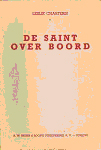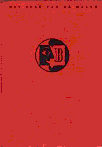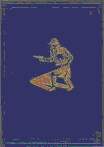Article Page 1
Article Page 2
Article Page 3
Article Page 4
Article Page 5
Bibliography
Cover Gallery 1
Cover Gallery 2
Cover Gallery 3
Cover Gallery 4
Cover Gallery 5
Cover Gallery 6
Cover Gallery 7
German covers by Regino Bernad
Le Saint Detective Magazine 1
Le Saint Detective Magazine 2
Le Saint Detective Magazine 3
Le Saint Detective Magazine 4
About Nero Wolfe & The Toff
About artist
Regino Bernad
The Saint on French Radio
French-English
Text Comparisons
De Saint (The Dutch Saint)
© 2008 Rinus Daane.
At this point in time, a total of 81 original Saint titles in Dutch translation
have been identified; they were all published by the Dutch publisher A.W.
Bruna & Zoon. There is no record of any other Saint publication by
any other Dutch publisher.
In the history of Bruna and the Saint novels, three time periods can be recognized.
Information on pre-1945 publications is, however, extremely scarce. The earliest evidence of publication of a Dutch
Saint can be found in the public catalogue of the Dutch National Library, which shows the release of a Dutch translation
of "Getaway" (Fayard 6). This was published in the Balkenseries. Since most books from the pre-1945 period
are undated, it is not known exactly when that series was initiated and ended. It ran at least between 1938 and
1941, and at least 6 Saint titles were published in that series. From the early Saints, 5 Dutch titles (all short
story collections) are still missing: Fayard 5, 9, 13, 18 & 76. It is still possible, although not very likely,
that they were published by Bruna before 1938 and never reprinted. Surprisingly, the catalogue of the Dutch National
Library does list a number of Hodder & Stoughton first editions, e.g. "The last hero" (1930), "Alias
the Saint" (1931), "The holy terror" (1932), "Boodle" (1934), "The misfortunes of
Mr. Teal" (1934) & "Saint overboard" (1936). It is on record that the Dutch publisher Bruna
had good relations, from 1923 on, with Hodder & Stoughton. Bruna also had a retail outlet for their books at
the railway kiosks, where they marketed the Hodder & Stoghton "Yellow jackets", and in the thirties,
they started translating "thrillers" from the British publisher and brought them on the market under
their own label. Although, only works of writers E. Philips Oppenheim and Edgar Wallace are explicitly mentioned
in a book about the history of the house Bruna, it is very likely that that also included Leslie Charteris books.
None of the pre-1945 Dutch Charteris' releases are available at this moment. But from available books in the Balkenseries
it can be deduced, that they probably were hardcover, linen editions with dustjackets. The name of the author,
and title was on the front of the cover and the back. The back also carried the logo for the series; a staff. Below
an example of a book, and logo, from this series, without the dustjacket:

![]()
Although still not very well documented, more information is available over the period 1946-1955. Before 1950,
a lot of books were still undated, but after 1950 most books were dated. Shortly after the war, Bruna started publishing,
and marketing books again. However, scarcity of paper meant that a lot of them were printed in Belgium. They were
cheap editions, soft cover carton binding, but with dustjackets. Two "Saints" from this period, including
the dust jacket, have been tracked down. There could be more. Without the dustjacket, the books had a very simple
design. The name of the author and title was on the back and also on the front, which also carried the name of
the publisher. An example of such a "Saint", without the dustjacket is shown below:

In 1948, Bruna initiated a new hard cover series "Boek van de Maand". Twelve books a year over the period
1948-1954. Several "Saints" were published in these series. They all had dustcovers, but were simultaneously
releases in two different bindings. There was a linen version, in different (plain) colours, most of them red.
And there was a leather version, in plain blue. Only the back carries the name of the author and the title, the
front carried a logo, different for each binding, but similar for every book released in these series. Below a
typical example of each binding and logo without the dustjacket, which was similar for each binding type:


linen + leather
In 1950, French publisher Fayard released the first of the Madeleine Michel-Tyl pastiches (Fayard 26), followed
in 1951 with Fayard 27 and in 1952 with Fayard 28. There is hard evidence that all three titles were published
by Bruna in 1952 in the "Boek van de Maand" series. This casts at least some serious doubts as to the
truth of the statement quoted in Burl Barer's book that.. "…the first
French Saints were reviewed and rejected by Bruna…".
After 1952, Bruna continued to translate and publish the French Fayard editions, although not always in the order
as they appeared in the Fayard series. Only the last three French pastiches from 1962, Fayard 71, 73 & 75 were
never published by Bruna, but that also holds for two original English versions "Trust the Saint" &
"The Saint in the Sun" from 1963, hence about the same time the Fayard Saint series was terminated.
Over the period 1950-1962, there must have been close connections between Fayard and Bruna. For many "Saint"
publications over that period, the Fayard edition was preferred over the original English publication, as evidenced
for instance by the release of Zwarte Beertjes nr. 248 in 1959 and nr. 742 in 1964, which are direct translations
of Fayard 51 & 69 respectively, which in their turn are translation of original stories, written and published
in English by Leslie Charteris.
It looks like around 1962 or 1963, Fayard and Bruna got disconnected, which explains the 5 missing Dutch translations
(3 French and 2 English titles) from that period. In 1965 "Vendetta for the Saint" was released as Zwarte
Beertjes nr. 934. The translation was based on the Hodder & Stoughton edition from 1965, restoring the old
relationship between those two publishing companies.
In 1954, Bruna reinitiated the "Balkenserie", but now with a semi-hard plasticized cover, they all were
reprints from earlier publications. The books, most probably, did not have a dustjacket. There is no evidence that
the series was continued after 1954. Most probably 5 "Saint" titles (3 available), all reprints, were
published in these series. Below an example from these series:

From 1955 on, all "Saints" appeared in pocket format under the imprint "Zwarte Beertjes", that
period is very well documented. The first Saint in the series was Zwarte Beertjes nr. 3 from 1955, a reprint of
a translation of "The last hero". The last Saint produced in this series was a translation of "Salvage
for the Saint", released in 1983 as Zwarte Beertjes nr. 2148.
After 1983, no new Saint translations were published. Under their own label, Bruna did publish a "Saint Omnibus"
in 1984, and a reprint (including the original cover) of "The Saint in New York" in 2005, to commemorate
the 50th anniversary of the existence of the "Zwarte Beertjes" series. There were several other reprints
of "Saints" after 1984, though under different labels, but all with the original © Bruna date on
it.
In sum the earliest evidence of any Saint publication by Bruna stems from 1938. No trace can be found for any of
five early Saint story collections i.e.
"Enter the Saint" (1930)
"Featuring the Saint" (1931)
"Alias the Saint" (1931)
"The brighter buccaneer" (1933)
"The Saint goes on" (1934)
At least from 1952 onwards, there was a strong connection between Bruna and Fayard. In that year Bruna published
the first three pastiches written by Madeleine Michel-Tyl (Fayard 26, 27 & 28). It ended somewhere in 1962.
In that year Bruna published "Le Saint au volant" (Fayard 66). In 1963 they published Fayard 68, but
it was published referencing the English title "The Saint and the sleeping beauty". The last three French
Saints, Fayard 73, 75 & 76 were never published. But surprisingly, also Fayard 77 & 78, i.e. the original
English releases "Trust the Saint" and "The Saint in the sun" were never integrally published;
most stories from those two bundles though were published at some point in The Saint Magazine's. On the other hand
Bruna did publish Fayard 69 "Les atout du Saint", a late collection of original English Saint stories,
in integrated form, directly from the Fayard release in 1964.
In none of the Bruna publications, there is any reference to Fayard in connection with Leslie Charteris. From 1964
on, starting with "Vendetta for the Saint," Bruna resumed Saint publications in chronological order of
appearance and did not miss any. At the same time they started making reference to Leslie Charteris as copyright
holder, but it lasted till 1978 until they made any reference to copyrights in any of the reprints of the French
Saints. The copyright always is to the correct year of the original Fayard publication, but always © Leslie
Charteris; Fayard is nowhere mentioned.
It appears that the hick-up in Saint publications around 1963, and the unexplained discontinuation of Fayard with
their Saint series, are connected events. Suggesting, that in both cases copyright issues between Fayard, Bruna
and Leslie Charteris played a significant role.
After 1963 there still were good contacts between Fayard and Bruna. From 1965 on Bruna published several French
authors in the "Zwarte Beertjes" and in many cases the books list © Librairie Arthème Fayard,
but this reference never occurred in connection with any Saint or Charteris publication. Hence it is quite possible,
that a conflict on "Saint" publication rights, between Fayard and the "Saint" copyright holders,
with Bruna caught in between, might eventually be responsible for both the termination of the Fayard Saint series,
and the missing 5 Saint titles by Bruna around 1963.
Below an overview is given of the Bruna "Saint" publications and their connection with the Fayard series,
based on the currently available information. The Bruna releases are listed in blue, and the original title on
which the translation was based (if known) is underlined. Only for the publications for which a dustjacket is available,
or those which never had a dustjacket, the various known covers are shown. All covers are reproduced to scale i.e.
a reduction to 20% of their original size. The list below further includes the name of the Dutch translator.
